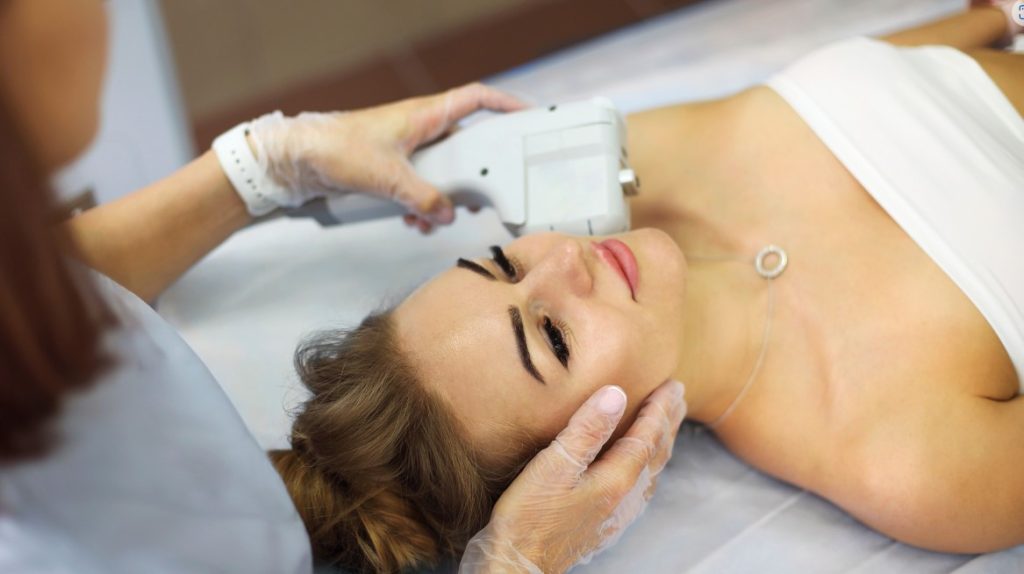HIFU, or High-Intensity Focused Ultrasound, is a non-invasive therapeutic technique used in both medical and cosmetic fields. In medical settings, HIFU is used to treat a range of conditions, including tumors and other tissue abnormalities, by delivering precise, focused ultrasound energy to heat and destroy the targeted tissue.
In the realm of cosmetic treatments, HIFU is popularly used for skin tightening and anti-aging purposes. It works by targeting deep layers of the skin, including the dermis and the superficial muscular aponeurotic system (SMAS), stimulating collagen production without damaging the skin’s surface. This process leads to a lifting and tightening effect, making it a sought-after treatment for facial rejuvenation, wrinkle reduction, and overall skin improvement. The non-invasive nature of HIFU makes it an appealing alternative to surgical facelifts, offering a way to achieve visible anti-aging results with minimal downtime.
High-Intensity Focused Ultrasound (HIFU) has a rich history and background, intertwining medical advancements and cosmetic applications. Developed initially for medical use, its roots can be traced back to the 1940s and 1950s when researchers began exploring the use of focused ultrasound in medical treatments.
Medical Beginnings
– 1940s-1950s: Initial experiments with focused ultrasound for therapeutic purposes.
– 1950s-1960s: Researchers, notably Fry brothers in the United States, conducted pioneering work in using ultrasound to treat neurological disorders.
– 1970s-1980s: Advancements in imaging technologies like MRI and ultrasound led to improved precision in HIFU applications, particularly in treating localized cancers and tumors.
Shift to Cosmetic Applications
– Late 1990s-2000s: With its potential in non-invasive tissue heating and destruction, HIFU began to be explored for cosmetic uses.
– 2000s: The first HIFU device for aesthetic purposes was introduced, focusing on skin lifting and tightening.
– 2010s: Rapid growth in the popularity of HIFU for cosmetic applications, particularly for facial rejuvenation, neck lifting, and body contouring.
Technology and Mechanism
HIFU technology uses focused ultrasound waves that converge on a specific tissue site deep within the body, generating localized heat. This heat destroys targeted cells without harming the surrounding tissues. In medical settings, this principle is used to treat tumors and lesions, while in aesthetics, it stimulates collagen production, resulting in skin tightening and rejuvenation.
Regulatory Approvals
– Medical Approvals: HIFU received regulatory approvals for treating various medical conditions, including prostate cancer and uterine fibroids.
– Cosmetic Approvals: In the cosmetic field, HIFU devices gained approvals for non-invasive eyebrow lifts and as a treatment for wrinkles and lines.
Current Status
In the present day, High-Intensity Focused Ultrasound (HIFU) stands as a beacon of innovation and versatility in both the medical and aesthetic landscapes.
Medical Applications:
- Cancer Treatment: HIFU plays a pivotal role in oncology, particularly in treating localized cancers such as prostate and liver cancer. It offers a non-invasive alternative to traditional surgical methods, targeting and destroying cancerous tissues with precision while sparing surrounding healthy tissues.
- Other Medical Conditions: Beyond oncology, HIFU is utilized for treating a variety of medical conditions including uterine fibroids, neurological disorders, and certain cardiovascular diseases. Its ability to focus ultrasound energy precisely makes it an effective tool in a range of therapeutic contexts.
Aesthetic Applications:
- Skin Rejuvenation: In the realm of cosmetic procedures, HIFU has become a favoured choice for non-invasive skin rejuvenation. Otherwise known as HIFU treatment for face, it has become a staple treatment in most aesthetic clinics. It is especially popular for facial lifting and tightening, addressing issues like sagging skin and wrinkles without the need for surgical intervention.
- Body Contouring: Extending its cosmetic benefits, HIFU is also being employed for body contouring, helping to sculpt and tone various body areas by targeting deeper fat layers and inducing collagen production.
Technological Evolution:
- Advancements in Precision and Safety: The technology behind HIFU is constantly advancing, with improvements focusing on enhancing its precision and safety. This evolution is making treatments more comfortable and effective for patients.
- Broader Range of Applications: Ongoing research is expanding the applications of HIFU, exploring its potential in treating additional medical conditions and enhancing its capabilities in aesthetic treatments.
The Future of HIFU:
- Research and Development: The future of HIFU is bright with continuous research and development. Emerging studies are delving into its potential in treating more diverse medical conditions and refining its use in aesthetic medicine.
- Global Recognition and Accessibility: As HIFU becomes more recognized globally, its accessibility is increasing, offering more patients the benefits of this innovative technology.
The current status of HIFU reflects its significant impact and growing importance in both medical and aesthetic fields. Its journey from a focused medical treatment to a revered cosmetic tool highlights its dynamic nature and the broadening scope of its applications. The ongoing advancements in HIFU technology are set to further cement its role as a key player in the evolving landscape of healthcare and beauty treatments.
